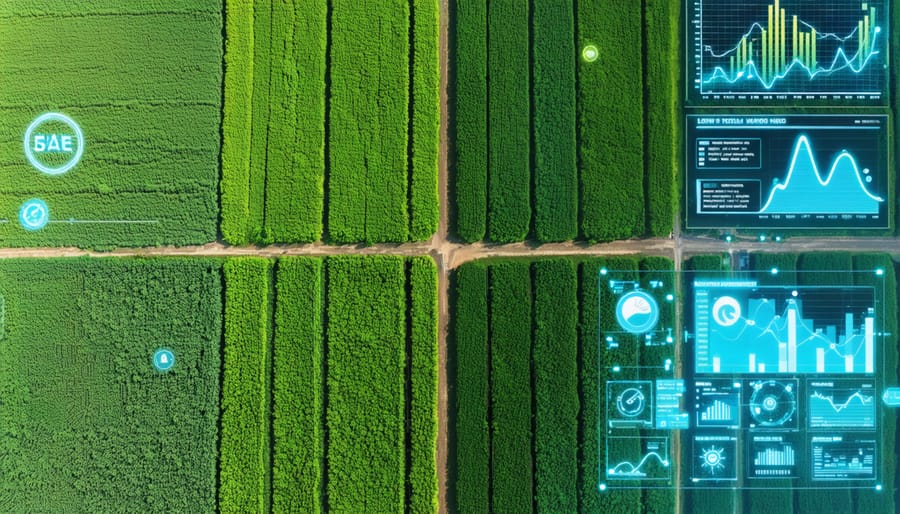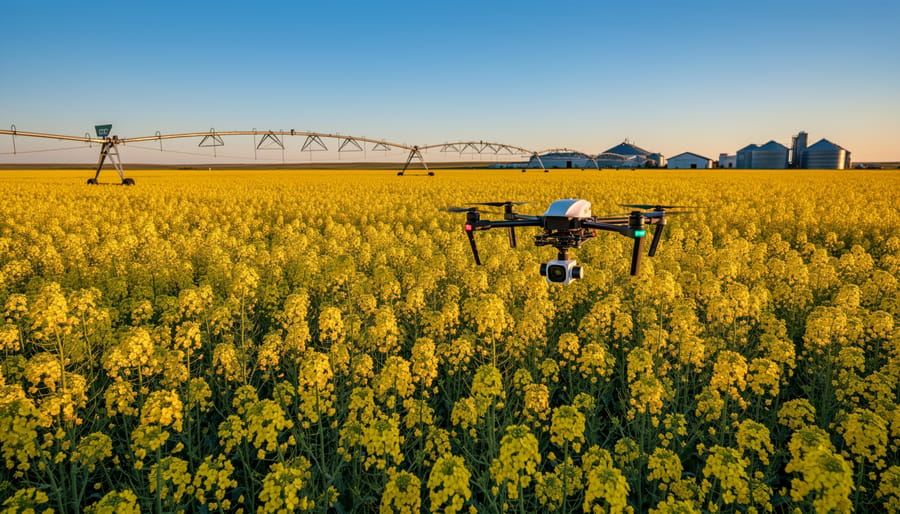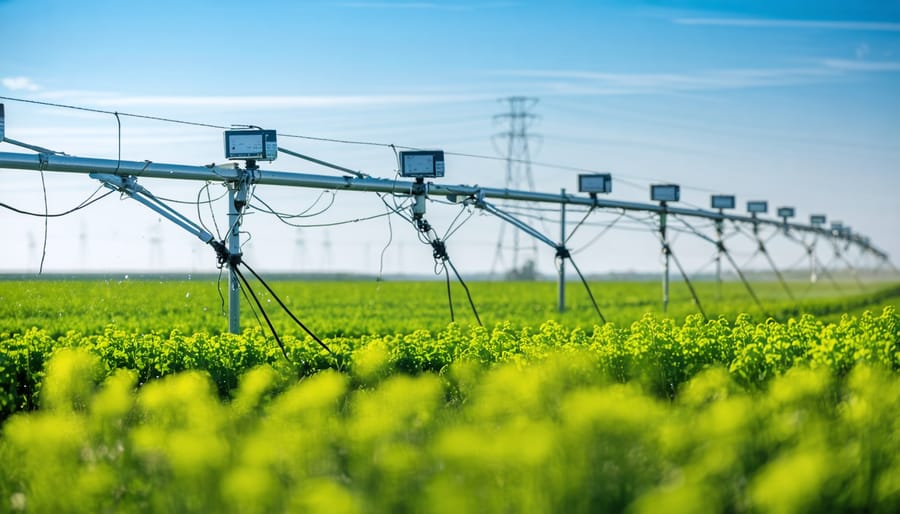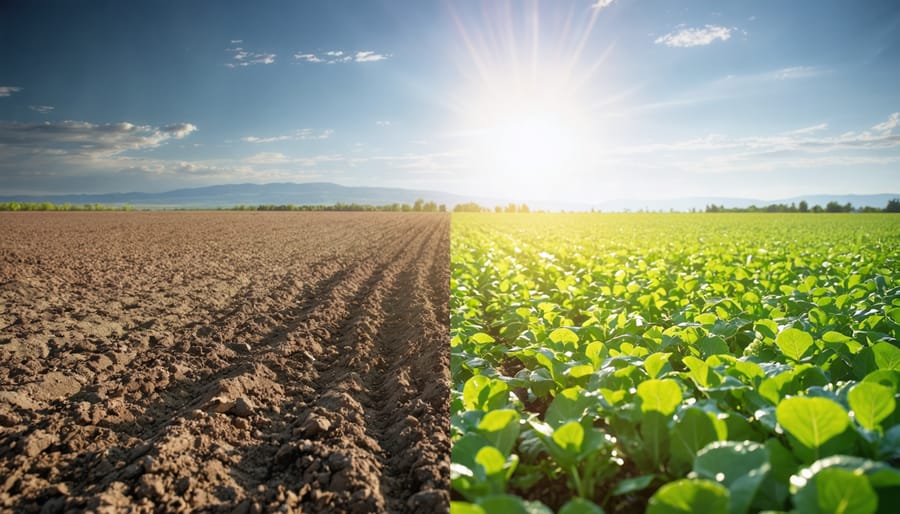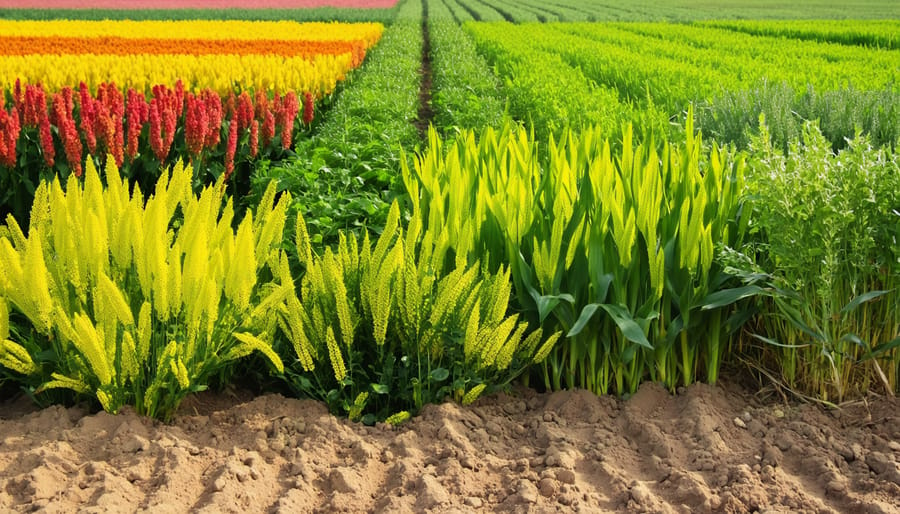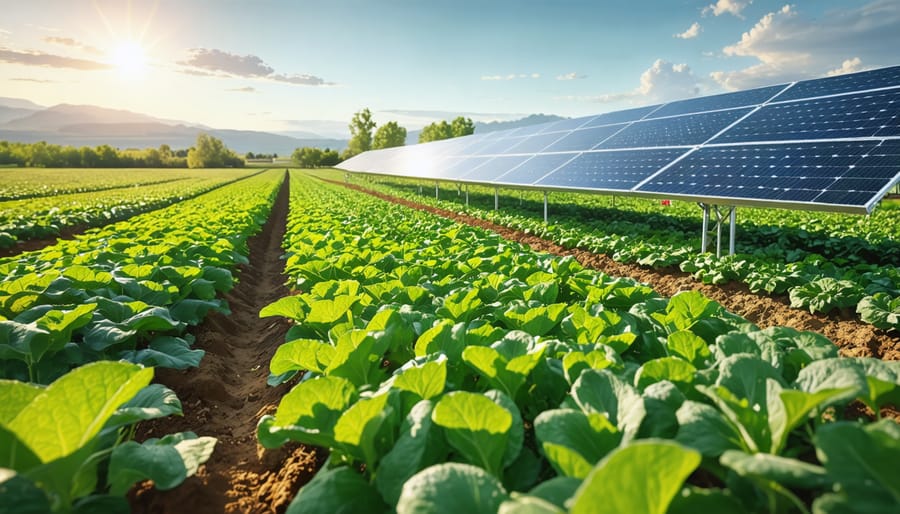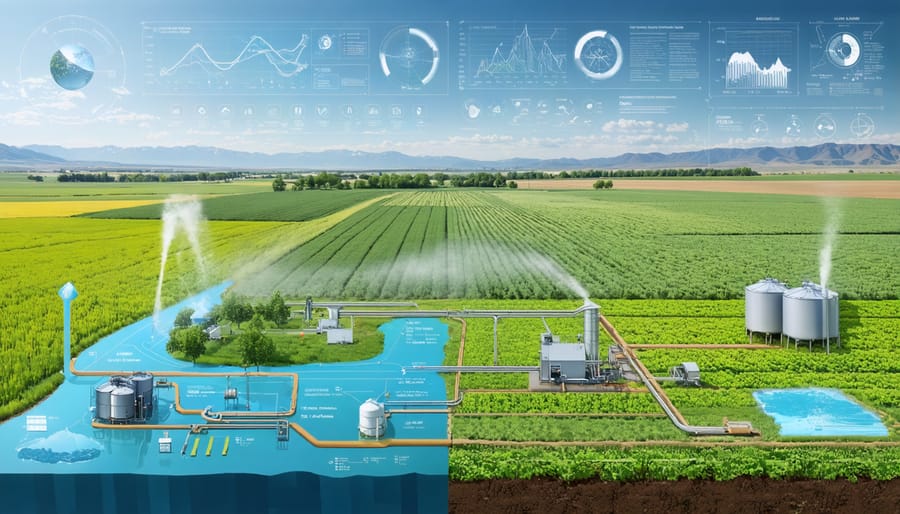Water shapes the future of Alberta’s farming landscape, where every drop counts in an era of changing climate patterns and increasing agricultural demands. Modern organic farmers face unprecedented challenges in managing this precious resource, yet innovative solutions are transforming how we approach irrigation and water conservation on Canadian farms.
From precision drip systems saving 40% more water than traditional methods to AI-powered soil moisture sensors delivering real-time data, technology is revolutionizing water management across the prairies. Alberta’s agricultural community has pioneered sustainable practices that maintain crop yields while reducing water consumption by an average of 30% over the past decade.
For organic farmers, particularly in water-stressed regions like Southern Alberta, integrating smart water management isn’t just about conservation – it’s about survival and growth. Leading producers are combining traditional knowledge with cutting-edge monitoring systems, achieving remarkable results: increased crop resilience, reduced input costs, and water savings of up to 60% compared to conventional methods.
This transformation in agricultural water management represents a crucial shift toward sustainable farming practices that protect both our natural resources and farm profitability. As we navigate increasingly unpredictable weather patterns, the intersection of farming and water management becomes not just an environmental imperative but a cornerstone of modern agricultural success.
How AI Water Analytics Transform Organic Farming
Real-Time Soil Moisture Monitoring
Modern farming in Alberta has embraced smart water monitoring systems that use AI-powered sensors to revolutionize how we track soil moisture. These sensors, typically placed at various depths throughout the field, provide real-time data about moisture levels, temperature, and soil composition. The information is transmitted wirelessly to your smartphone or computer, allowing for immediate adjustments to irrigation schedules.
Local farmers have reported significant improvements in their soil moisture optimization efforts using these systems. The sensors work by measuring electrical conductivity and dielectric permittivity of the soil, providing accurate readings within 2% margin of error. Data is collected every 15 minutes, creating detailed moisture maps that help identify areas requiring immediate attention.
The system also integrates weather forecasts and historical data to predict future moisture needs. For organic farmers, this technology has proven particularly valuable in maintaining optimal growing conditions while conserving water resources. Many Alberta producers have found that these monitoring systems pay for themselves within two growing seasons through reduced water usage and improved crop yields.
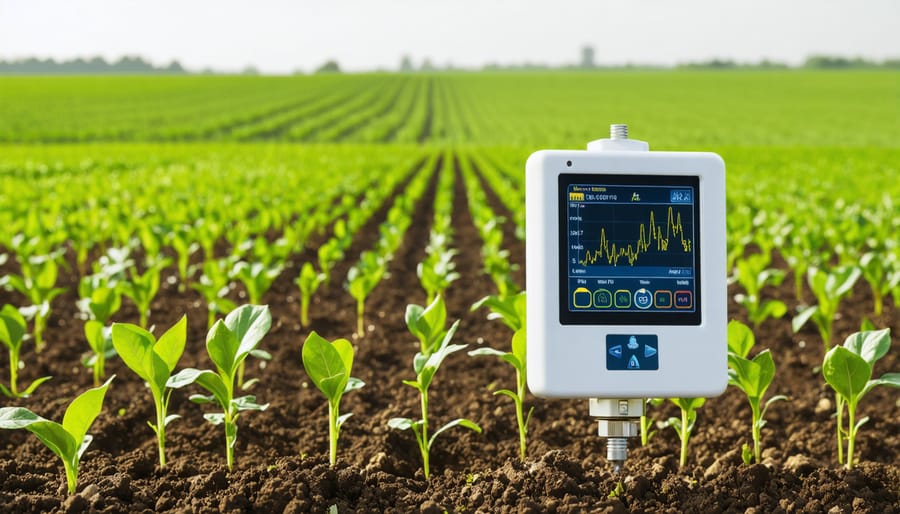
Predictive Irrigation Scheduling
Modern farming in Alberta is being revolutionized by AI-powered irrigation scheduling systems that take the guesswork out of when and how much to water. These smart systems analyze real-time data from soil moisture sensors, local weather stations, and satellite imagery to create precise watering schedules tailored to specific crop needs.
By incorporating multiple data points, including soil type, crop growth stage, and upcoming weather patterns, these systems can predict optimal watering times up to two weeks in advance. For example, at the Morrison Family Farm near Lethbridge, implementing predictive irrigation has reduced water usage by 30% while maintaining crop yields.
The technology considers factors like precipitation forecasts, evapotranspiration rates, and crop water stress indicators to make informed decisions. When rain is predicted, the system automatically adjusts irrigation schedules to prevent overwatering. This not only conserves water but also helps prevent disease and nutrient leaching.
Farmers can access these predictions through user-friendly mobile apps, allowing them to review and adjust recommendations based on their experience and local conditions. The system continues to learn and improve its predictions through machine learning, becoming more accurate with each growing season.
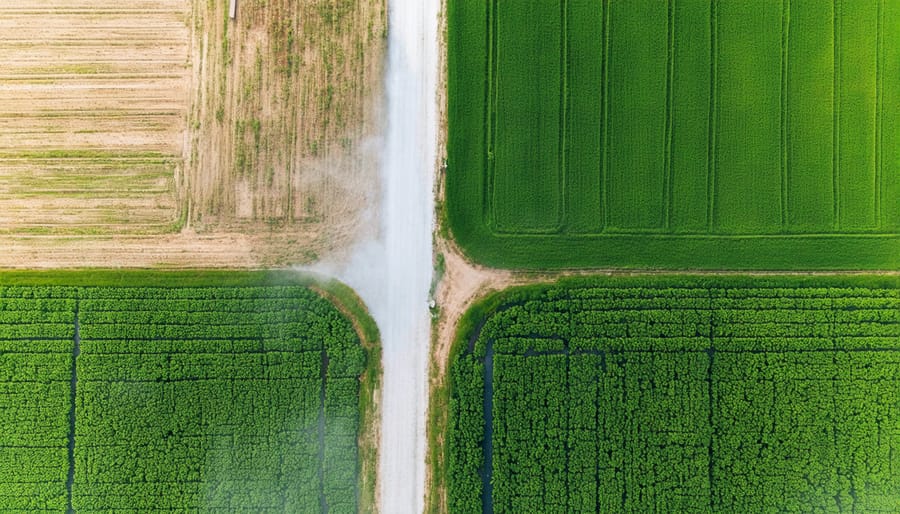
Alberta Success Story: The Miller Family Farm
Implementation Process
Setting up an efficient water management system on your farm involves several key steps that ensure successful integration and long-term sustainability. Begin by conducting a thorough water audit of your property, mapping out existing water sources, irrigation systems, and areas requiring improved water access.
Next, assess your soil composition and drainage patterns across different field sections. This information helps determine the most suitable irrigation methods for your specific needs. Consider installing soil moisture sensors at various depths to monitor water retention and distribution effectively.
Work with local agricultural extension services to develop a customized implementation plan. They can help you select appropriate equipment and technology based on your farm’s size and crop types. For most Alberta farms, a combination of drip irrigation and precision sprinklers proves most effective.
Install your chosen system in phases, starting with a pilot area to test effectiveness and make necessary adjustments. Begin with the main water supply infrastructure, followed by distribution networks and control systems. Modern systems often include automated controls that can be managed through smartphone apps.
During implementation, train your farm team on system operation and maintenance. Document standard procedures and create troubleshooting guides specific to your setup. Regular maintenance checks should be scheduled, particularly before peak growing seasons.
Remember to factor in seasonal changes typical to Alberta’s climate when programming your system. This ensures optimal water usage throughout the year while maintaining crop health and soil quality.
Results and ROI
Recent studies across Alberta’s farming regions demonstrate impressive results from implementing modern water management practices. On average, farms using precision irrigation systems report water savings of 30-40% compared to traditional methods, while maintaining or improving crop yields.
A 2022 case study of the Lethbridge region showed that farms using soil moisture sensors and automated irrigation systems reduced their water consumption by 35%, saving approximately 100,000 litres per hectare annually. These same farms reported a 15% increase in crop yield, particularly in water-intensive crops like potatoes and sugar beets.
The financial returns are equally compelling. Initial investment in water management technology, averaging $75,000 for a mid-sized farm, typically achieves payback within 2-3 growing seasons. Operating costs decrease by roughly 25% due to reduced water usage, lower energy consumption, and optimized labour allocation.
Quality improvements have also been noted, with participating farms reporting a 20% reduction in crop disease incidents related to over-watering. This translates to better market prices and reduced crop loss. Additionally, farms implementing these systems have seen their soil health scores improve by an average of 40% over three years, contributing to long-term sustainability.
For small-scale operations, even basic water management improvements, such as installing soil moisture monitors, have shown returns of $3-5 for every dollar invested within the first year of implementation.
Getting Started with AI Water Management
System Components and Costs
Implementing effective water management systems requires careful consideration of both essential equipment and associated costs. A basic setup typically includes soil moisture sensors ($150-300 per unit), weather monitoring stations ($500-1,200), and automated irrigation controllers ($300-800). For larger operations, investing in precision irrigation systems can range from $15,000 to $50,000 per quarter section, depending on complexity and coverage area.
These proven water-smart practices often require initial infrastructure investments, but many Alberta farmers report ROI within 2-3 growing seasons through reduced water consumption and improved yields.
Additional components may include:
– Water flow meters ($200-600)
– Drip irrigation lines ($0.50-1.50 per metre)
– Smart valve controllers ($400-900)
– Data management software ($30-100 monthly subscription)
Many agricultural equipment dealers offer financing options, and government grants through the Canadian Agricultural Partnership can offset 30-50% of costs. Local irrigation districts sometimes provide cost-sharing programs for modernization projects.
Before investing, consider starting with basic monitoring equipment and gradually expanding based on observed benefits. Many suppliers offer equipment trials or demonstrations, allowing farmers to test systems before making significant investments.
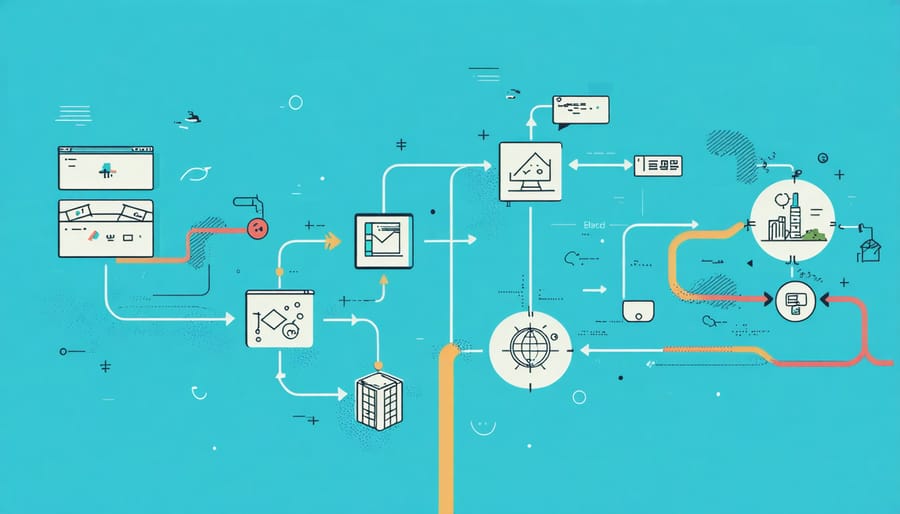
Available Grants and Support
Canadian farmers have access to several key funding programs to support water management initiatives and technology adoption. The Canadian Agricultural Partnership (CAP) offers grants of up to $100,000 for implementing water-efficient irrigation systems and smart monitoring technologies. In Alberta specifically, the Irrigation Efficiency Program provides cost-sharing opportunities covering up to 40% of eligible expenses for upgrading to precision irrigation equipment.
The Environmental Farm Plan (EFP) program supports farmers with both technical assistance and financial incentives when implementing water conservation practices. Completing an EFP can unlock additional funding streams and typically covers 30-50% of project costs related to water management improvements.
For organic farmers, the Organic Science Cluster program offers specialized grants focusing on sustainable water management practices, with funding amounts ranging from $5,000 to $50,000 per project. The Agricultural Clean Technology Program provides zero-interest loans and grants for implementing water-saving technologies, including AI-driven irrigation systems and soil moisture sensors.
Local watershed groups and conservation authorities often provide smaller grants ($1,000-$5,000) for specific water stewardship projects. The Agriculture and Agri-Food Canada’s AgriInnovate program offers larger-scale funding for commercial farms implementing innovative water management solutions, with contributions up to $10 million for qualifying projects.
For application support and guidance, farmers can connect with their regional agricultural extension office or local watershed coordinator.
Integration with Existing Systems
Modern AI-powered water management systems can seamlessly integrate with your existing irrigation infrastructure, making the transition both cost-effective and practical. Many Alberta farmers have successfully upgraded their conventional pivots and sprinklers by adding smart sensors and control units without replacing entire systems.
The process typically begins with a farm assessment to identify which components of your current setup can be enhanced with AI capabilities. Key integration points include flow meters, soil moisture sensors, and automated control valves. These components connect to a central hub that processes data and adjusts water distribution accordingly.
For example, the Thompson family farm in Lethbridge successfully integrated AI analytics with their 15-year-old pivot system by installing wireless sensors and a smart controller. This upgrade allowed them to implement climate-adaptive irrigation solutions while maintaining their existing infrastructure.
Most modern AI systems use standard protocols that work with equipment from major manufacturers like Valley, Zimmatic, and Reinke. The integration process typically takes 2-3 days and can be completed during off-peak seasons to minimize disruption to farming operations.
Remember to work with certified technicians who understand both traditional irrigation systems and smart technology. Many local agricultural service providers now offer specialized integration services tailored to Alberta’s unique farming conditions.
The integration of AI water analytics in organic farming represents a significant step forward for Alberta’s agricultural community. By embracing these innovative technologies, farmers across our region have demonstrated that sustainable water management and profitable organic farming can go hand in hand. The data shows that farms implementing AI-driven irrigation systems typically see water savings of 20-30% while maintaining or improving crop yields.
As we’ve seen from local success stories, the initial investment in smart water management systems pays dividends through reduced water consumption, lower operational costs, and improved crop quality. For organic farmers particularly, these systems provide precise control over water distribution, supporting compliance with certification requirements while maximizing resource efficiency.
Looking ahead, the adoption of AI water analytics isn’t just about individual farm success – it’s about strengthening our entire agricultural community’s resilience to climate challenges. With available government grants and support programs, there’s never been a better time for Alberta farmers to make this transition. By working together and sharing our experiences with these technologies, we can ensure a sustainable future for organic farming in our region while preserving our precious water resources for generations to come.

